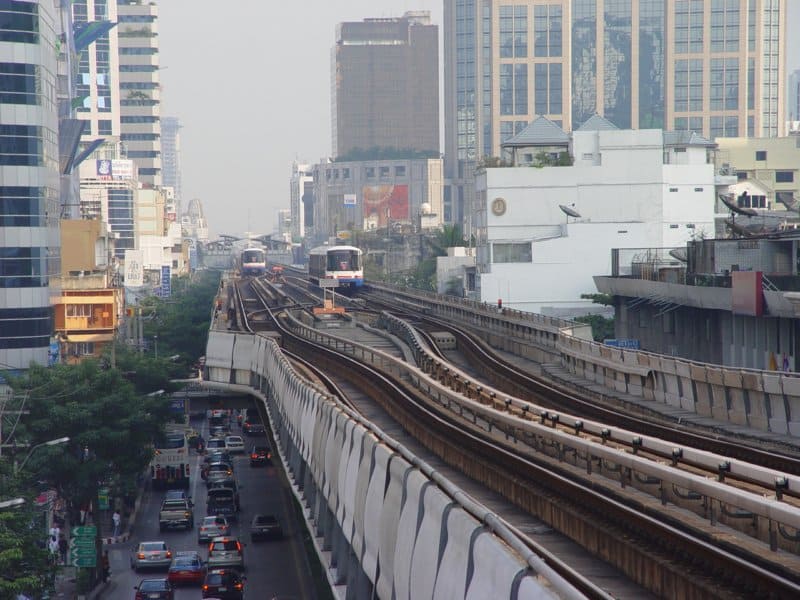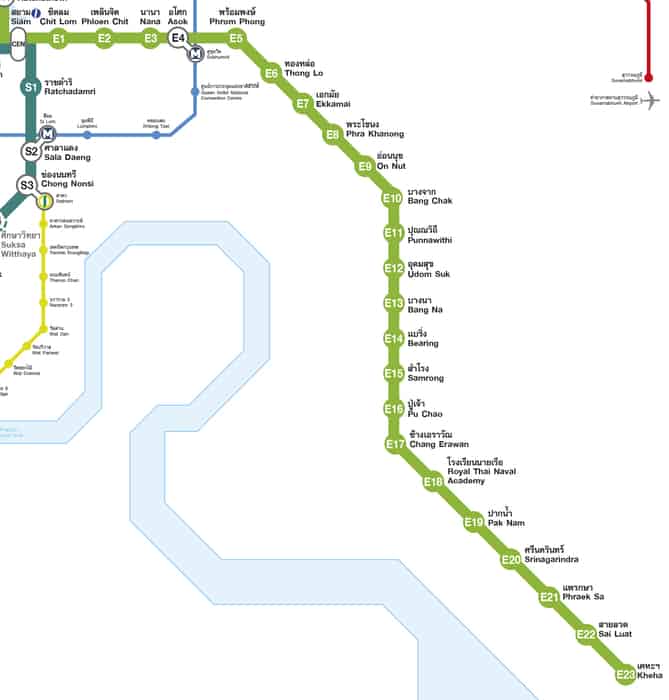
If you’re looking to learn about using the BTS Skytrain in Bangkok, this article is for you. I’ve detailed fares, boarding, departure, and almost any other questions you might have about the BTS. If you’re looking for a quick one-time use guide follow these steps:
Use a self-service kiosk at any station to purchase your ticket. Fares will vary based on destination. Tap your ticket on the green arrow at the gates to enter, but keep your ticket. Depart at your destination and insert your ticket at the gate to exit.
Why use the BTS? Traffic in Bangkok is horrible and ranked 11th worst in the world in 2019 congestion levels from tomtom. I’ve gone into more detail as to why traffic is so horrible in this article, but peak times for morning and evening rush hours are 7AM and 6PM. If you’re traveling around these times, I’d recommend taking the BTS.
Finding Your Destination
What Time Does BTS Skytrain Open?
The Sukhumvit Line starts at 5:15 AM and the Silom Line starts at 5:30 AM. Both lines run until midnight.
BTS Skytrain Map
This map is directly from the BTS website and you can check fare rates there as well:



There are two lines, the Suhkhumvit Line (light green) and the Silom Line (dark green/turquoise). The Sukhumvit Line runs from Wat Phra Sri Mahathat to Kheha. The Silom Line runs from Bang Wa to National Stadium.
Siam Station is where both lines connect. This is the busiest station in Bangkok and it’s also close to many popular locations downtown.
Getting Your Ticket
To ride the BTS Skytrain, you need a Single Journey Card, One-Day Pass, or a Rabbit Card. The Rabbit Cards have the option to add stored value or add a bundle of “trips” that expire after 30 days. A major drawback of the 30-day trip option is that the trips can only be used on the original 25 stations. There are currently 52 BTS stations.
The Rabbit Card stored value option can be used on all 52 stations.
The major advantage of using a Rabbit Card is to avoid long ticket queues. During rush hours, waiting in line for tickets can be excruciatingly long.
BTS Bangkok Fare
Fares are subject to change and can be viewed at the BTS website here. At the time of writing this article, these are current fares:
Single Journey Card: Fares range from ฿0-59 Baht depending on distance. If you’re traveling just a few stations, there is no fare charge.
One-Day Pass: ฿140 Baht, non-refundable
Rabbit Card Stored Value: Rabbit Cards charge an issuing fee of ฿100 Baht which is non-refundable. To add funds to your account, a minimum value of ฿100 Baht can be added and a maximum storage of ฿4000 Baht is allowed. Fares are automatically deducted from your Rabbit Card balance upon use.
Current fares for Rabbit Cards are the exact same as Single Journey Cards, but there are discounts offered on Student and Senior Rabbit Cards.
You can top up your Rabbit Card at any BTS Ticket Office or anywhere with an authorized “top up” service. Top-up service providers include BTS, BRT, McDonalds, Tesco Lotus, Big C, The Mall Food Hall, Inthanin, and others.
Rabbit Card 30-Day Trips: Trips are only usable on the original 25 stations and expire 30 days after the first use. Below fares are for adult cards:
- 15 trips ฿465 Baht (฿31 Baht/trip)
- 25 trips ฿725 Baht (฿29 Baht/trip)
- 40 trips ฿1,080 Baht (฿27 Baht/trip)
- 50 trips ฿1,300 Baht (฿26 Baht/trip)
How to Get BTS Skytrain Tickets
All cards are available for purchase at any BTS Skytrain station. Self-service kiosks are available for Single Journey Cards. The Ticket Office is available for purchasing any cards.
Single Journey Cards: In the past, self-service kiosks have only accepted coins, but this may change. If you need coins, you can visit the Ticket Office for assistance. Once you have coins and know your destination, look at the map to the left or right of your self-service kiosk and find your destination. There will be a circled number, which is the fare for that destination.
Enter your destination’s fare and then insert your coins. Take your ticket and receipt then move on to boarding.
One-Day Pass: Available at any BTS Ticket Office.
Rabbit Card: The Rabbit Card is valid for 7 years from the issuing date and is available for purchase at any station or online from Klook. Klook offers pickup at the Suvarnabhumi Airport and cards include a ฿200 Baht prepaid balance.
It is highly recommended to use the Rabbit Card with stored value if you are planning to travel on the BTS regularly. You will avoid lengthy ticket queues. I would avoid using the 30-day trips option offered by these cards since they only cover the 25 original stations.
How to Use Rabbit Card on BTS
Once you have your Rabbit Card pre-loaded with Baht as explained in the sections above, you’re able to use it to enter through the automatic gates. Simply tap your card on the card reader where the green arrow is displayed. To exit, do the same. You do not need to insert your Rabbit Card anywhere. For a more detailed guide, visit the BTS website here.
Is Rabbit Card Refundable?
Rabbit will generally refund the stored value of the card per request. You can bring your card to an authorized service center (a BTS station) and visit the Ticket Office to initiate the process. Rabbit will refund the stored value within 15 days from request. You can also deliver your card to the company directly. As long as the card is not expired or inactive, you should not have any problems receiving a refund.
This is directly from the Rabbit website and is subject to change, to verify this information for yourself, visit the website here (refund section is about halfway down the page).
Boarding the Skytrain
Once you know your destination and have purchased your ticket, it’s time to find your train.
The two lines (Sukhumvit and Silom) are independent but have a central hub, Siam Station, that connects them. If you’re boarding on one of the Sukhumvit stations and want to travel to a Silom station, you’ll need to interchange at Siam Station.
To change lines at the Siam Station, you’ll see signs directing you towards one of the 4 end stations: Bang Wa, National Stadium, Kheha, or Wat Phra Sri Mahathat. Go to the end station that is in the direction you are traveling. For example, if you’re at Siam Station and want to go to Mo Chit, follow the arrows to Wat Phra Sri Mahathat since that train will stop at Mo Chit.
If you’re traveling within the same line, the same rule applies. Find the end station that is in the direction of your destination and exit at your destination.
If it is during rush hour or is a busy station, people will wait in line to board the Skytrain. Be respectful, wait in line, and board when it is your turn.
You need your ticket for the entrance gates and the exit gates, so make sure not to lose it.
End Stations:
Wat Phra Sri Mahathat (Sukhumvit Line North)
Kheha (Sukhumvit Line South)
National Stadium (Silom Line East)
Bang Wa (Silom Line West)
How Fast Is the BTS Skytrain?
The BTS Skytrain in Bangkok travels at an average speed of 22 mph (35 km/h) and a top speed of 50 mph (80 km/h).
Departing the Skytrain
When exiting the BTS Skytrain, you will follow the exit arrows and insert your ticket to get past the exit gate. You won’t need to make any additional payments if you originally paid the correct fare.
Does BTS Skytrain Connect to Airport?
The BTS connect to BKK Airport through the Airport Rail Link. There is an independent subway line called the Airport Rail Link (ARL) that meets the BTS at the Phaya Thai stop. Using the ARL is one of the most efficient ways to travel to and from the airport to the city. It makes booking your stays along the BTS lines much more convenient as you’ll be able to travel directly from the airport to your accommodation without needing a taxi.
Most Popular BTS Skytrain Stops
Siam and National Stadium
Shopping: These two neighboring stops, Siam Station and National Stadium Station, are the most popular stops for retail shopping centers and malls. The MBK Shopping Center of Bangkok (Ma Boon Khrong Center) is the most well-known retail establishment in Bangkok and is accessible from the National Stadium stop. Souvenirs are available on floors 3 and 6.
Alternative nearby malls include Siam Discovery, Siam Center, and Siam Paragon, but you’re likely to find the best deals at MBK. If you’re looking for a more upscale experience, Siam Paragon is a great mall to visit.
4D Movies: The AIS 4DX Theater is also in the area. 4D is a great way to watch a film and gives and exciting feeling as if you’re in the screen. You will move, smell, see, and listen to events on screen. I’d recommend action or fantasy movies.
Madame Tussauds: A popular wax attraction that allows you to interact with life-like wax figurines. You can get wax hands made, see wax celebrities, and play interactive games.
The Bangkok Art & Culture Centre (BACC): Offers a wide collection of art pieces in an architecturally magnificent building. A great place to grab coffee and visit various exhibits.
Sea Life Bangkok Ocean World: Another popular tourist attraction close to these stops and hosts over 8,000 creatures. I thought this place was pretty interesting when I visited because the entrance is on the floor/basement level of the mall. I didn’t like that they charge tourists a higher price than Thai citizens, so I didn’t tour this place.
Mo Chit
Chatuchak Weekend Market: The Chatuchak Weekend Market is a 35-acre indoor/outdoor market with over 10,000 shops. You can find all sorts of products ranging from handmade goods, arts, souvenirs, pets, and most importantly food. It’s one of the best tourist locations in Bangkok and highly recommended to visit.
Nana and Sala Daeng
Nightlife: Nana and Sala Daeng stops are well-known areas for nightlife. They’ll put you in walking distance of bars, clubs, and both red light districts. The Nana red light district is just across the street from the stop and the Sala Daeng red light district is right around the corner from the station as well.
Ekkamai and Victory Monument
Transportation Hubs: Both of these stops are great transportation hubs to exit Bangkok and visit rural areas. Ekkamai has many different buses that transport all throughout Thailand. Victory Monument has a few bus stops as well and some minivan buses to popular tourist destinations like Ayutthaya.
Night Market: Victory Monument station is right next to a popular night market.
MRT Interchange Stations
Silom Line: Sala Daeng and Bang Wa stations have MRT interchanges.
Sukhumvit Line: Asok, Mo Chit, and Ma Yaek Lat Phrao have MRT interchanges.
Chao Phraya Express Interchange
Access to Chao Phraya Express boats are at Saphan Taksin along the Silom Line.
Can I Take the BTS to the Grand Palace?
If you’re planning to visit the Grand Palace, there is no direct BTS stop for that location. It is only accessible via mass transit by river taxi (Chao Phraya Express Boats) or bus. I’d recommend taking a river taxi by exiting the BTS at the Saphan Taksin station and taking the Chao Phraya Express Boats from there.
